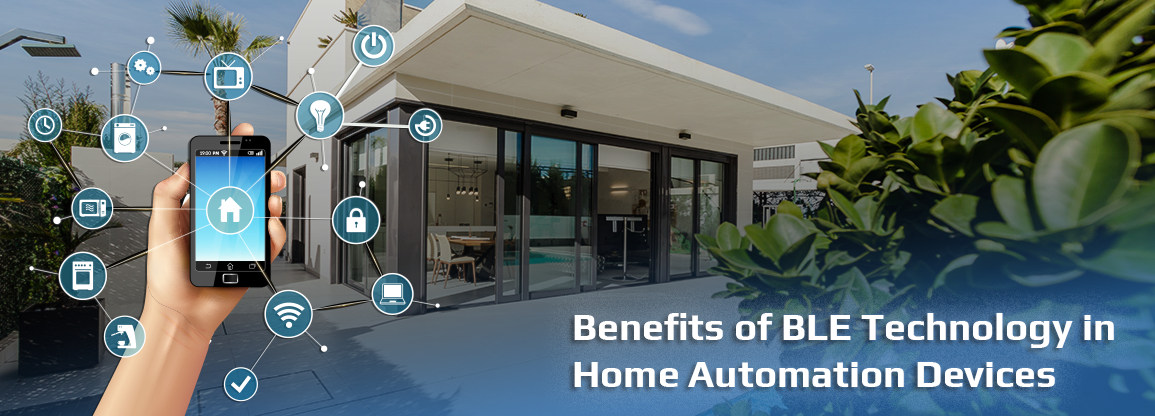Benefits of BLE Technology in Home Automation Devices
- by BLE Mobile Apps

Nowadays, the concept of the smart home has become more than just a cool factor. The aim for achieving convenience and performance that is worthwhile for your investment has made the use of Bluetooth smart home devices prominent. There are almost 180k devices that are available for home automation systems. This blog covers the benefits of Bluetooth Low Energy in Home Automation Technology.
Why BLE technology?
There’s WiFi, Z-Wave, and ZigBee, but why go with BLE technology. It is simple as BLE technology is prevalent, very energy efficient, and costs significantly less money. Therefore, Bluetooth Smart is in the cards to win the network protocol battle for the below whys and wherefores:
- Widespread Usage – It is present already in the smartphones we all use and other similar smart devices.
- Low Energy Consumption – BLE is known for its minimal energy consumption, incredibly important for devices that run on batteries.
- Mesh Network Format Support – Since June 2017, BLE protocol is supporting mesh networks officially.
Bluetooth Smart Home Devices Market
The smart home business segment share was $32.5 billion in 2017 and is anticipated to grow more and reach up to $58.68 billion by the end of 2020. Home automation technology has many sub-segments. The Commercial Real Estate market, Retail, Smart Home, and Banking are some of the most in-demand segments. Over 3.6 billion devices are expected to be installed by the year 2021.
Benefits of Bluetooth Smart Home Devices
People can now control the IoT devices using voice, smartphone, or tablet, be it BLE iOS, BLE Android. Else, self-learning devices can take care of the controlling part. Daily tasks can be made simpler by setting up alerts that can be sent to their smartphones. Data gathered from sensors for lights; windows, doors, temperature, motion detection can be shared with respective applications and directed to the cloud. Smart home appliances can also be activated in response to the data received. BLE solutions are apt for home heating, lighting, and ventilation systems, and wearables. Their benefits in various aspects are below given.
- Electricity Consumption – The use of Bluetooth low energy android or Bluetooth low energy iOS devices control electricity consumption vastly by utilizing Bluetooth powered smart meters. Bluetooth low energy technology makes sure that digital electricity meters perform precisely and efficiently. It can be used for various home appliances, like electric heating devices, electric cookers, and AC systems, to cap power consumption and wastage without physically turning off the devices.
- Smart Heating – Some of the smart thermostats make use of BLE for controlling remotely via smartphone. Usually, smart heating devices need a WiFi connection as it could mess with Bluetooth connections. So, BLE is often preferred for small thermostats that can be smartphone-controlled.
- Home Sensors – Smoke, water, and fire sensors the essential components of every smart home. Even motion sensors are becoming quite common. These sensor devices are powered by a battery and can be positioned wherever and activated anytime or whenever you are away from home. Notification will be sent to your smartphone. Motion sensors can work in conjunction with other smart home elements like measuring temperature or adjusting light intensity according to the natural light. Also, motion detectors could be linked with an accelerometer such that this feature can turn a light off after the baby is asleep.
- Automate Home Security – Having smart linked with Smartphone apps acts like digital keys that could be shared with family and friends. It can lock and unlock and send you alerts. Many Bluetooth Low Energy smart locks can easily be hacked because of how the locks implemented Bluetooth communications or the lock’s companion smartphone apps, which transmit their user passwords in plain text to smartphones.
- Routine Task Automation – Tasks such as turning lights on and off, playing/stopping music, opening or closing the door, starting the car, running robotic vacuum cleaners are just a few among many more. Smart lighting is one of the most practical and widely used tasks. Currently, many smart bulbs need to connect to your smartphone through a home automation hub; however, there are other bulbs available that can connect directly to a phone.
- Automate Home Health – Bluetooth medical devices and equipment such as heart rate monitors, body motion and temperature sensors, glucose monitors, and other Bluetooth smart medical devices are of great help in smart homes. Workouts in the home gym can be tracked with Bluetooth powered heart rate monitors. Daily the system undergoes updates on the medical data gathered when a person is staying at home.
- Mesh network – Bluetooth technology executes a managed flood approach was only the main-powered nodes act as message relays. Low-power nodes, like the sensors that are battery-powered, are not in charge of message relay. When it comes to Bluetooth mesh networks, low-power nodes with a coin-sized battery can function for many years. Smartphone applications support Bluetooth mesh networking with the help of mesh proxy protocol. This protocol allows establishing communication with the mesh network through a proxy node.
Conclusion
Smart homes and every other sector are looking for an energy management approach. Bluetooth Low energy is being sought out for efficient and long-standing communication between home appliances. Integrating smart home network applications are on the rise, and BLE technology has a profound place in Home Automation Technology.
